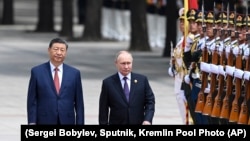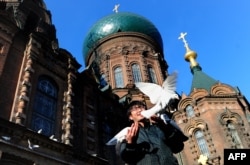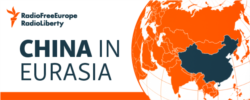In a state visit rich in symbolism, Russian President Vladimir Putin will go to Harbin, a northeastern Chinese city with deep cultural and historic links to Russia, as part of a bid to trumpet burgeoning economic and political ties between the two countries.
Putin will use his May 17 Harbin visit -- the second of a two-day trip to China meant to cement his relationship with Chinese leader Xi Jinping -- to attend a "gala" marking 75 years of diplomatic ties between the countries and to attend trade and cooperation forums in the city.
The capital of China's northeastern Heilongjiang Province that borders Russia's Far East, Putin will also visit the Harbin Institute of Technology, a site of joint research between China and Russia and an institution with deep links to China's military and defense industry.
While Putin was greeted with pomp and pageantry in Beijing alongside Xi, the Russian leader will look to use the Harbin visit to show that Russian-Chinese ties are deeper than the two leaders shared goal of pushing back against the United States and the West on the world stage.
During Putin's May 16 stop in Beijing, he praised China as Russia's top trade partner -- with turnover ballooning to $240 billion in 2023 -- and said the countries had learned the lessons of "the history of our relationship at different stages of its development" in an interview with China's state-run Xinhua News Agency before his visit.
Speaking alongside Putin, Xi said China was prepared "to consolidate the friendship between the two peoples for generations to come."
A Symbolic Stop
Once nicknamed "Little Moscow," Harbin has strong links to tsarist Russia and was once home to tens of thousands of ethnic Russians, many of whom were settlers during railway construction or fled to the city during the 1917-22 Russian Civil War.
The area was also the site of border tensions between China and the Soviet Union when conflict erupted in 1969, but has become increasingly connected to Russia's Far East in recent years as Russian-Chinese trade has grown.
While much of its Orthodox-style architecture has been replaced, Harbin's famous and towering St. Sophia Cathedral still sits in the heart of the city. Tourists across China and Russia flock to Harbin for its annual Ice and Snow Festival.
Resisting Western Pressure
The Harbin Institute of Technology that Putin is slated to visit has been home to exchange and joint research between China and Russia for more than a century and is also one of China's most important military research universities. The institution is one of the "Seven Sons of National Defense" universities -- a government label that means it reports to the Industry and Information Technology Ministry, which also controls China's defense industry.
According to a study by Georgetown University's Center for Security and Emerging Technology, the institution and its six other peer universities provide about three-fourths of the technical graduates recruited by China's defense companies.
The university was also included in sanctions by the U.S. government in 2020 for its alleged role in procuring items for China's military.
With revamping its defense industry and military cooperation with China a focus of the trip, Putin brought a large delegation of high-ranking Russian officials with him -- including newly appointed Defense Minister Andrei Belousov.
Beyond Xi And Putin
Ever since the Russian and Chinese leaders declared a "no-limits" bilateral strategic partnership in February 2022, the strength of their relationship has been put to the test.
While Putin proclaimed that "Russia-China relations have reached an all-time high, and even in the face of severe international situations, relations between the two countries continue to strengthen" before departing from Moscow, China has had to perform an awkward diplomatic straddle.
Xi has faced growing diplomatic and economic pressure from the West to curtail any support that aids Russia's war in Ukraine, with Washington accusing Beijing of aiding the Kremlin's war machine through the trade of dual-use equipment like satellite intelligence, fighter jet parts, and microchips.
Senior U.S. officials have also warned of sanctions against banks in China and "significant consequences" on Chinese companies that assist Russia's war effort.
In visiting Harbin, Putin is looking to offset some of this pressure by showing that the China-Russia relationship is more than just geopolitics.
Harbin and the region are a bustling hub for trade between China and Russia and the exodus of Western brands from Russia following Moscow's full-scale invasion of Ukraine created a void that was swiftly filled by Chinese manufacturers, which now dominate Russian markets from smartphones to household appliances.
The top six foreign car brands in Russia are all Chinese, with around 60 percent of newly sold cars in Russia this year due to be imported from China, almost double the share in 2022, according to Russian and Chinese customs data. China's Xiaomi and Tecno have eclipsed Apple and Samsung in Russia's smartphone market and the Chinese yuan has become the most traded currency on the Moscow stock exchange.
In Harbin, Putin will look to underscore those burgeoning links by visiting a China-Russia trade expo and an economic forum meant to further boost economic ties between the two countries.












